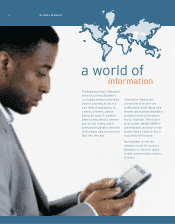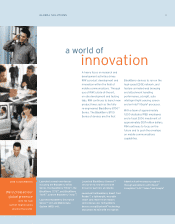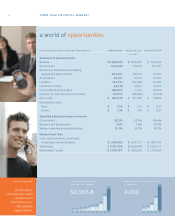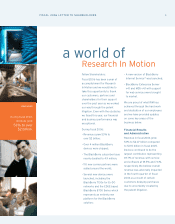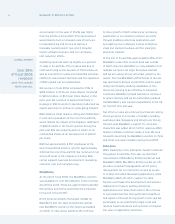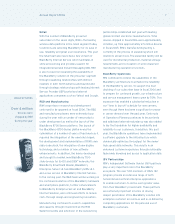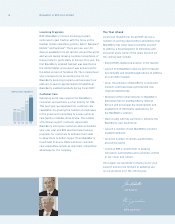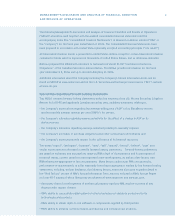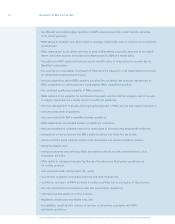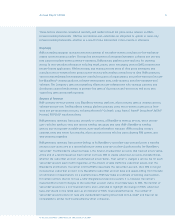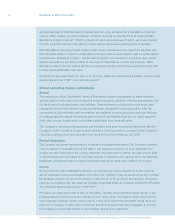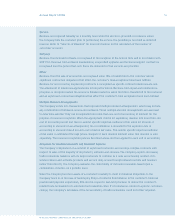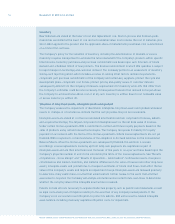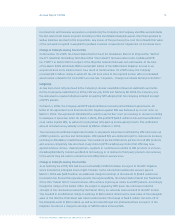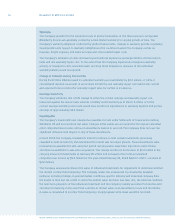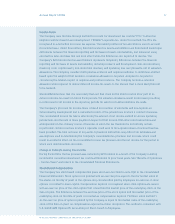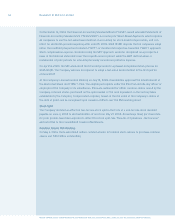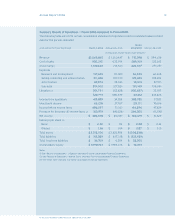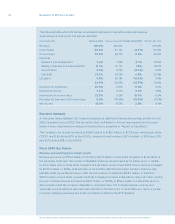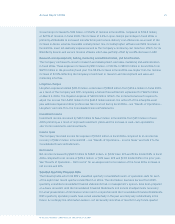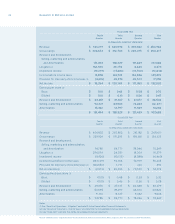Blackberry 2006 Annual Report Download - page 14
Download and view the complete annual report
Please find page 14 of the 2006 Blackberry annual report below. You can navigate through the pages in the report by either clicking on the pages listed below, or by using the keyword search tool below to find specific information within the annual report.
Research In Motion Limited
12
Research In Motion Limited • Incorporated Under the Laws of Ontario (In thousands of United States dollars, except per share data, and except as otherwise indicated)
An important part of RIM’s BlackBerry wireless platform is the software that is installed on corporate
servers and/or desktop personal computers. Software revenues include fees from (i) licensing RIM’s
BlackBerry Enterprise Server® (“BES”) software; (ii) client access licenses (“CALs”), which are charged
for each subscriber using the BlackBerry service; and (iii) maintenance and upgrades to software.
RIM’s BlackBerry licensing program enables mobile device manufacturers to equip their handsets with
the integrated ability to connect to a BlackBerry Enterprise Server and transport data using BlackBerry
infrastructure. BlackBerry ConnectTM and BlackBerry Built-InTM are designed to provide an open, global
platform and address the distinct needs of end users, IT departments, carriers and licensees. RIM’s
BlackBerry Internet Service related services use the same wireless architecture and infrastructure that
is being used by RIM’s BES customers.
Revenues are also generated from sales of accessories, repair and maintenance programs, non-recurring
engineering services (“NRE”) and technical support.
Critical Accounting Policies and Estimates
General
The preparation of the Consolidated Financial Statements requires management to make estimates
and assumptions with respect to the reported amounts of assets, liabilities, revenues and expenses and
the disclosure of contingent assets and liabilities. These estimates and assumptions are based upon
management’s historical experience and are believed by management to be reasonable under the
circumstances. Such estimates and assumptions are evaluated on an ongoing basis and form the basis
for making judgments about the carrying values of assets and liabilities that are not readily apparent
from other sources. Actual results could differ signicantly from these estimates.
The Company’s critical accounting policies and estimates have been reviewed and discussed with the
Company’s Audit Committee. Except as disclosed below, there have been no changes to the Company’s
critical accounting policies and estimates from those disclosed as at February 26, 2005.
Revenue Recognition
The Company recognizes revenue when it is realized or realizable and earned. The Company considers
revenue realized or realizable and earned when it has persuasive evidence of an arrangement, the
product has been delivered or the services have been provided to the customer, the sales price is xed
or determinable and collectibility is reasonably assured. In addition to this general policy, the following
paragraphs describe the specic revenue recognition policies for each major category of revenue.
Revenue from the sale of BlackBerry devices is recognized when title is transferred to the customer
and all signicant contractual obligations that affect the customer’s nal acceptance have been fullled.
For hardware products for which the software is deemed not to be incidental, the Company recognizes
revenue in accordance with the American Institute of Certied Public Accountants Statement of Position
97-2,
Software Revenue Recognition
(“SOP 97-2”).
Provisions are made at the time of sale for warranties, royalties and estimated product returns. If the
historical data the Company uses to estimate product returns does not properly reect future returns,
these estimates could be revised. Future returns, if they were higher than estimated, would result in a
reduction of revenue. To date, returns of devices and other products have been negligible. As a result,
the Company’s accrual with respect to such product returns is not signicant.


